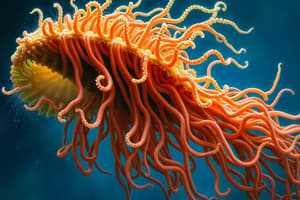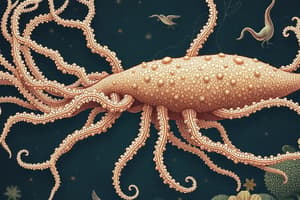Podcast
Questions and Answers
Which of the following are general characteristics of cnidarians? (Select all that apply)
Which of the following are general characteristics of cnidarians? (Select all that apply)
- Stinging tentacles (correct)
- Soft bodied (correct)
- Carnivorous (correct)
- Fast swimmers
What type of symmetry do cnidarians exhibit?
What type of symmetry do cnidarians exhibit?
Radial
Cnidarians do not have specialized tissues.
Cnidarians do not have specialized tissues.
False (B)
What does the word 'cnidaria' derive from?
What does the word 'cnidaria' derive from?
What are the cells called that sting?
What are the cells called that sting?
How do cnidocytes function?
How do cnidocytes function?
What are nematocysts connected to?
What are nematocysts connected to?
What effect can the poison from cnidarians have?
What effect can the poison from cnidarians have?
How many species of cnidarians are there?
How many species of cnidarians are there?
What type of environment do cnidarians live in?
What type of environment do cnidarians live in?
What does 'marine' mean?
What does 'marine' mean?
What does 'benthic' mean?
What does 'benthic' mean?
Describe the digestive system of a cnidarian.
Describe the digestive system of a cnidarian.
What type of digestive system do cnidarians have?
What type of digestive system do cnidarians have?
Describe an incomplete digestive system.
Describe an incomplete digestive system.
Describe the respiratory system of cnidarians.
Describe the respiratory system of cnidarians.
Describe diffusion.
Describe diffusion.
Cnidarians require gills, lungs, or tracheae.
Cnidarians require gills, lungs, or tracheae.
Describe the nervous system of cnidarians.
Describe the nervous system of cnidarians.
What can many cnidarians do after being attacked?
What can many cnidarians do after being attacked?
Match each cnidarian form with its description:
Match each cnidarian form with its description:
What are the four major classes of cnidaria?
What are the four major classes of cnidaria?
Describe Anthozoa.
Describe Anthozoa.
Flashcards are hidden until you start studying
Study Notes
General Characteristics of Cnidarians
- Soft-bodied and carnivorous animals
- Equipped with stinging tentacles
- Considered the simplest form of animal life
- Exhibit radial symmetry
Cnidocyte Functionality
- Stinging cells called cnidocytes contain nematocysts, which are specialized stingers
- Nematocysts catch prey and provide protection from predators
Species and Habitat
- Over 9,000 species of cnidarians exist
- Habitats include all aquatic environments; primarily marine, with some residing on the ocean bottom (benthic)
- Marine environments are characterized by saltwater
Digestive and Respiratory Systems
- Cnidarians possess an incomplete digestive system, featuring a single opening for ingestion and waste excretion
- Gastrovascular cavity acts as both stomach and site for nutrient absorption
- Gas exchange occurs directly by diffusion, eliminating the need for specialized respiratory organs like gills or lungs
Nervous System and Regeneration
- Nervous system includes a nerve net and simple receptors for basic movement and sensory functions
- Many cnidarians can regenerate lost parts after being attacked
Life Forms and Reproduction
- Exist in two forms: polyp (sessile, asexual reproduction) and medusa (motile, sexual reproduction)
- Asexual reproduction commonly occurs through budding, leading to genetically identical colonies
- Sexual reproduction is external; gametes unite in water to form swimming larvae that eventually settle and transform into polyps
Movement Mechanisms
- Polyp movement involves a basal disk that secretes a sticky substance for attachment and gas bubbles for detachment
- Hydras exhibit somersaulting movement, while medusas employ jet propulsion
Major Classes of Cnidarians
- Four main classes: Anthozoa, Hydrozoa, Scyphozoa, and Cubozoa
Anthozoa Class
- Commonly referred to as "flower animals"
- Includes true corals, sea anemones, and sea fans
- Typically bottom-dwelling and thrive in shallow waters, reliant on light for symbiotic relationships with algae
- Coral polyps deposit lime from their exoskeletons, contributing to the formation of coral reefs over time
Studying That Suits You
Use AI to generate personalized quizzes and flashcards to suit your learning preferences.




